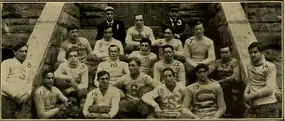| Biographical details | |
|---|---|
| Born | February 21, 1883 Lancaster, Texas, U.S. |
| Died | September 11, 1957 (aged 74) Houston, Texas, U.S. |
| Playing career | |
| 1906–1907 | Sewanee |
| Position(s) | End |
| Coaching career (HC unless noted) | |
| 1910 | TCU |
| Head coaching record | |
| Overall | 2–6–1 |
| Accomplishments and honors | |
| Awards | |
| All-Southern (1907) | |
Howard Guy "Kemp" Lewis (February 21, 1883 – September 11, 1957), also known as Guy Lewis, was an American college football player and coach and engineer. He played end at Sewanee: The University of the South in 1906 and 1907 and was selected to the 1907 College Football All-Southern Team. Kemp served as the head football coach at Texas Christian University (TCU) for one season, in 1910, compiling a record of 2–6–1. He "pioneered in the forward pass and the change in the shape of the ball from round to oval."[1]
Sewanee
Lewis was a prominent 5 feet 11 inches, 165-pound end for the Sewanee Tigers football team of Sewanee: The University of the South. He was from Dallas, Texas.[2]
1906

Rival Vanderbilt coach Dan McGugin mentioned Lewis as one of the best ends in the South in 1906, but preferred moving running back Frank Shipp to end for his All-Southern team.[3] That same season, Lewis caught a pass and ran 85 yards for a touchdown against Tulane.[1]
1907
Lewis was selected All-Southern in 1907 for one of Sewanee's greatest teams.[4][5] Sewanee lost the effective SIAA championship game to rival Vanderbilt on a double pass play then thrown near the end zone by Bob Blake to Stein Stone. Honus Craig then ran in the winning touchdown. It was just the second year of the legal forward pass. The trick play was cited by Grantland Rice as the greatest thrill he ever witnessed in his years of watching sports.[6] Innis Brown later wrote "Sewanee in all probability had the best team in the South."[5]
TCU
After graduating from Sewanee, Lewis worked for the government as an engineer. In 1910, he was appointed the head football coach at Texas Christian University (TCU).[7]
Later life and death
Lewis moved to Houston around 1939 and worked with the United States Army Corps of Engineers there until retiring in 1953. He died at the age of 74, on September 11, 1957, at his home in Houston.[8]
Head coaching record
| Year | Team | Overall | Conference | Standing | Bowl/playoffs | ||||
|---|---|---|---|---|---|---|---|---|---|
| TCU (Texas Intercollegiate Athletic Association) (1910) | |||||||||
| 1910 | TCU | 2–6–1 | 0–1 | ||||||
| TCU: | 2–6–1 | 0–1 | |||||||
| Total: | 2–6–1 | ||||||||
References
- 1 2 "With Sewanee Alumni". Sewanee Alumni News. XXIII (4): 25. November 1957. Retrieved August 23, 2021 – via Internet Archive.
- ↑ "Tigers Are A Husky Bunch". Atlanta Constitution. November 9, 1907. p. 11. Retrieved April 11, 2015 – via Newspapers.com.

- ↑ National Collegiate Athletic Association (1907). The Official National Collegiate Athletic Association Football Guide. pp. 27, 49 – via Google books.

- ↑ Dan McGugin (1907). "Southern Intercollegiate Athletic Association Foot Ball". The Official National Collegiate Athletic Association Football Guide. National Collegiate Athletic Association: 71–75.
- 1 2 "Brown Calls Vanderbilt '06 Best Eleven South Ever Had". Atlanta Constitution. February 19, 1911. p. 52. Retrieved March 8, 2015 – via Newspapers.com.

- ↑ "Grantland Rice Tells Of Greatest Thrill In Years Of Watching Sport". Boston Daily Globe. April 27, 1924. ProQuest 497709192.
- ↑ "New Football Tutor". The Fort Worth Record and Register. Fort Worth, Texas. June 26, 1910. p. 13. Retrieved August 22, 2021 – via Newspapers.com
 .
. - ↑ "Ex-T. C. U. Gridman's Funeral Saturday". Fort Worth Star-Telegram. Fort Worth, Texas. Associated Press. September 13, 1957. p. 8. Retrieved August 22, 2021 – via Newspapers.com
 .
.